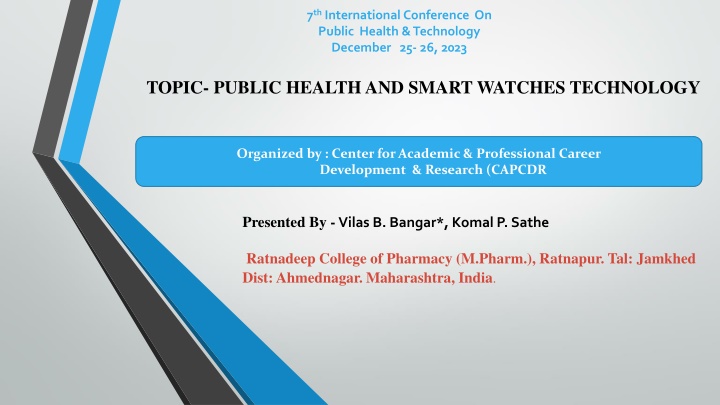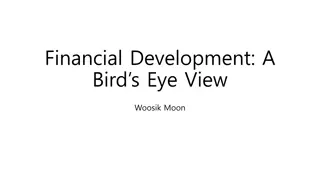
Smart Watches in Public Health: Advancements and Implications
Explore the intersection of public health and smart watch technology, including the potential for real-time health monitoring, disease prevention, and treatment. Learn about regulatory considerations, research reviews, and search strategies for relevant information sources in this rapidly evolving field.
Uploaded on | 3 Views
Download Presentation

Please find below an Image/Link to download the presentation.
The content on the website is provided AS IS for your information and personal use only. It may not be sold, licensed, or shared on other websites without obtaining consent from the author. If you encounter any issues during the download, it is possible that the publisher has removed the file from their server.
You are allowed to download the files provided on this website for personal or commercial use, subject to the condition that they are used lawfully. All files are the property of their respective owners.
The content on the website is provided AS IS for your information and personal use only. It may not be sold, licensed, or shared on other websites without obtaining consent from the author.
E N D
Presentation Transcript
7th International Conference On Public Health & Technology December 25- 26, 2023 TOPIC- PUBLIC HEALTH AND SMART WATCHES TECHNOLOGY Organized by : Center for Academic & Professional Career Development & Research (CAPCDR Presented By -Vilas B. Bangar*, Komal P. Sathe Ratnadeep College of Pharmacy (M.Pharm.), Ratnapur. Tal: Jamkhed Dist: Ahmednagar.Maharashtra, India.
PUBLIC HEALTH AND SMART WATCHES TECHNOLOGY As wearable technology and medical devices come together to monitor personal health in real-time, including cardiovascular health metrics, smartwatches are witnessing phenomenal growth in the mobile technology sector. With these gadgets, consumers can now obtain a personalized medical data report that may help with disease prevention and treatment. an formula called the Framingham Risk Score was created to evaluate a person's 10-year risk of cardiovascular disease. These clever gadgets will assist caretakers in being more vigilant and implementing more suitable comfort measures, as many patients are unable to explain their situation to their friends or family members. The concept of comfort measures has garnered noteworthy interest in nursing and medical literature, as it represents a methodical strategy that encompasses both proactive involvement and deliberate limitation. Clinical smartwatches that capture and process data as well as detect medically relevant events have been approved by the FDA. The European Union (EU) does not currently have any authorized direct-address smartwatches. However, makers of smartwatches have to navigate a number of frameworks, including the Medical Device Regulation 2017/745 and the Radio Equipment Directive 2014/53/EU, in order to comply with EU rules. These laws address important topics such as electromagnetic compatibility and effective radio spectrum usage, with a focus on safety standards. 2
METHOD REASON for scoping review The scope was made because artificial intelligence and machine learning algorithms are emerging technologies applicable to smartwatches. In addition, research evaluations are useful for evaluating the effectiveness of large-scale or new studies [14]. The purpose of research reviews is to identify and map relevant evidence on a topic, content, context, or question that meets predefined inclusion criteria [ 19, 20]. A research review can gather a variety of evidence from different domains, including empirical and non-empirical sources 3
SEARCH STRATEGY AND INFORMATION SOURCES The first step to identify articles related to this topic was a limited search of PubMed/Medline, SCOPUS, Embassy, Network of Sciences and ERIC. To develop a comprehensive search strategy, the text words in the titles of the relevant articles and the index terms used to describe the articles were analysed (see Table 1). Depending on the database and/or data source, the search strategy was adjusted to include all identified keywords and index terms. Additional studies were screened from a reference list of all included sources of evidence. We also searched various grey literature sources to ensure that all relevant information was obtained. The review team searched relevant grey literature databases (eg, Grey Literature Report, Google Scholar, Open Grey, and Web of Science Conference Proceedings) for studies, reports, and conference abstracts of interest. A research librarian developed a search strategy and modified it based on stakeholder feedback. To avoid bias, the research team blinded stakeholders to the initially developed search strategy. Considering that the medical applications of smart watches have only recently been introduced to the market, the application period was limited to the period after 2017. After the search, all the citations found were collected in the EndNote 8 database and duplicates were removed. 4
RESULT Descriptive After assessing the quality of the articles, 32 studies were analysed for information. Most of the studies were conducted in the United States (N=10), three in China, three in Taiwan, three in the United Kingdom (UK), Finland, Germany, Norway and Spain, two studies each and one study in other countries (Greece, Switzerland, Slovenia, Canada, Australia, Belgium, Brazil and France). 13 studies were experimental, four were cohort studies, and one study of each design (longitudinal cohort study, longitudinal observational study, multicentre study, randomized controlled trial (RCT), randomized, accelerometric data, combined method, feasibility study, observational study, prospective. , non- randomized and refereed blinded study , Prospective, single-arm, cross-sectional, prospective comparative and prospective study Figure 2 shows the distribution of these studies graphically Analysis of the keywords used in these studies shows that most were related to smart watches, Covid- 19 and digital health. A visual representation of their distribution is given in Figure 3 5
BLOOD PRESSURES Hypertension is a major risk factor for heart disease, and discontinued devices cannot be used in clinical practice. More studies in both normotensive and hypertensive subjects are needed to increase the reliability of smartwatch-based blood pressure measurements. In the study by Falter [33], consecutive patients scheduled for 24-hour ambulatory blood pressure monitoring were recruited from an outpatient cardiology clinic. Validated devices were used for measurement, including an automatic upper arm blood pressure monitor with a cuff and a Samsung Galaxy Watch Active 2 smart watch that was calibrated. Patients took multiple measurements using both traditional blood pressure monitors and smart watches over at least 24 hours to ensure accuracy. In a total of 40 patients, the smart watch overestimated blood pressure up to 140 mmHg, then underestimated blood pressure, illustrating relative and differential bias. Smartwatch measurements are more accurate at higher blood pressure readings, while the gold standard method is less accurate at lower blood pressure readings. 7
HEART DISEASE Cardia Band is an Apple Watch accessory that can diagnose atrial fibrillation (AF) using an automatic algorithm. In a non-randomized study [34], patients with AF used KB before and after elective CV procedures. The accuracy of the automatic KB algorithm was evaluated by comparing its results with physician-interpreted KB rhythm strips and simultaneous ECGs. The study found that automated interpretation of KB had high sensitivity and specificity in diagnosing AF compared with physician- interpreted 12-lead ECG and KB rhythm strip. the algorithm correctly diagnosed AF with 93% sensitivity, 84% specificity, and a K-factor of 0.77 compared with electrophysiologist-interpreted ECGs. The doctor's interpretation showed similar results: 99% sensitivity, 83% specificity, and a K- factor of 0.83 to assess the quality of KB traces produced by smart watches. PPG technology is used to passively and continuously monitor AF detection algorithms using modern handhelds. 8
COVID PANDEMIC A recent study carried out at the Scripps Research Translational Institute investigated the potential of data from wearable sensors to predict patterns of the spread of the coronavirus in 2019. The research team analysed data consisting of 333 participants who actively used the smartphone program DETECT. The It app allowed people to enter their symptoms and test results while collecting additional biometric data, such as heart rate and sleep patterns, using commercially available mobile devices. By incorporating symptom-based indicators and sensor-generated data into the analytical model, researchers achieved significantly higher accuracy in distinguishing between positive and negative cases compared to models based only on symptoms [36]. The Iota-based system was developed to collect signals from Samsung Gear Sport smart watches every two hours for 12 minutes. PPG signals were used to extract parameters related to heart rate and heart rate variability. During the study, physical activity and sleep were measured using a Samsung watch, and TST and WASO were calculated for each night. The Stats Model Python package was used for data analysis, and HRV, physical activity and sleep measures were the dependent variables. The results of this study showed that pandemic-related restrictions were associated with increased heart rate variability, stress levels, physical activity and decreased sleep duration. Pregnant women benefit from using Internet of Things (Iota) technologies to track their daily well-being patterns [37]. The occurrence of lung damage and possible post- treatment injuries is a major concern in the context of the widespread COVID-19 epidemic 9
CONCLUSION Advances in technology have led to the number of e-patients who rely on technology to track and monitor their illnesses. Integrating medical curricula is critical to improving communication skills and addressing e- patient engagement issues. Wearable technologies such as smart watches are increasingly popular in healthcare, but their integration presents challenges. The review highlights the link between smartwatches and their effectiveness in healthcare systems. Smart watches can be effective in diagnosing and reporting symptoms, early detection of potential health risks and monitoring patients with chronic diseases. However, security considerations must be taken into account, as most smartwatches are designed for ease of use rather than for medical diagnosis. The reliability of smart watches in healthcare is also a concern due to the lack of transparency of their algorithms and variable results in diagnosing clinical symptoms. Instead, the healthcare network is increasingly in demand for clinical assistants powered by AI. These types of assistants could provide more accurate and reliable information, being better equipped to handle the complexities of healthcare. Given these findings, further research is needed to understand and exploit the potential of smart watches in healthcare and to develop more advanced and effective clinical assistants that use artificial intelligence technology. 10
References 1. Case MA, Burwick HA, Volpp KG, Patel MS. Accuracy of smartphone applications and wearable devices for tracking physical activity data. JAMA. 2015;313(6):625 6. Manini TM, Mendoza T, Battula M, Davoudi A, Kheirkhahan M, Young ME, Weber E, Fillingim RB, Rashidi P. Perception of older adults toward smartwatch technology for assessing pain and related patient-reported outcomes: pilot study. JMIR Mhealth Uhealth. 2019;7(3): e10044. . Piwek L, Ellis DA, Andrews S, Joinson A. The rise of consumer health wearables: promises and barriers. PLoS Med. 2016;13(2): e1001953. score and prediction of coronary heart disease death in young men. Am Heart J. 2007;154(1):80 6. Jahangiry L, Farhangi MA, Rezaei F. Framingham risk score for estimation . Oliveira I. Comfort Measures: A Concept Analysis. Res Theory Nurs Pract. 2013; 27:114 95. . 10. Prieto-Avalos G, Cruz-Ramos NA, Alor-Hern ndez G, S nchez-Cervantes L, Rodr guez-Mazahua L, Guarneros- Nolasco LR. Wearable devices for physical monitoring of heart: a review. Biosensors. 2022;12(5):292. Kondrath S, Maddi R. Technical documentation requirements for medical devices approval in European union and a detailed emphasis on air-way products. J Innov Appl Pharm Sci (JIAPS). 2021:48 53. . Henn DK, Ruppert T. The new approval procedure for clinical trials of medicinal products in the European Union- challenges for the pharmaceutical industry in Germany. Bundesgesundheitsblatt Gesundheitsforschung Gesundheitsschutz. 2023;66(1):28 37. . Dunn J, Kidzinski L, Runge R, Witt D, Hicks JL, Sch ssler-Fiorenza Rose SM, Li X, Bahmani A, Delp SL, Hastie T. Wearable sensors enable personalized predictions of clinical laboratory measurements. Nat Med. 2021;27(6):1105 12. 10. Isakadze N, Martin SS. How useful is the smartwatch ECG? Trends Cardiovasc Med. 2020;30(7):442 8. 2. 3. 4. 5. 6. 7. 8. 9. 11
Thank you . 12






















